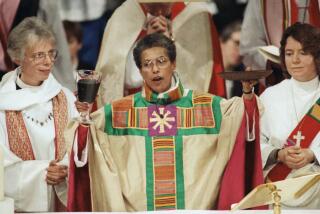Non-Traditional Ministries, Profound Changes : Many Nuns Now Forsake Convent
- Share via
SAN BERNARDINO — Betty Schaefer was 19 when she put on a white wedding dress provided by the convent of the Dominican Order of Sisters and took her first religious vows. She became Sister Davida, taking her mother’s maiden name, and every day wore a black veil and long white tunic. She taught at Catholic schools. At night, even while she slept, she was required to keep her head covered.
Twenty-five years later, she is presiding over church services in a pair of red plaid trousers, a red turtleneck and red shoes at a poor, urban parish here. She lives alone in a house that was once the priests’ rectory, and spends her days running the parish, visiting the sick and working with the poor of San Bernardino.
She is still a nun, bound by vows of obedience, poverty and celibacy. But, like thousands of other nuns around the nation since the reforms of Vatican II, she has forsaken the traditional sisters’ work of teaching school and convent life for active leadership in the church and an independent living.
During the last two decades, the life styles of American nuns have changed profoundly. Most now wear ordinary street clothes and attractive hair styles. Many have moved from large convents into apartments or houses shared by three or four sisters doing different jobs.
Fewer teach in Catholic schools. Instead, they work with the homeless, alcoholics or troubled teen-agers. They still run hospitals, but many now are physicians as well as nurses. Some are canon lawyers. A growing number, like Sister Davida, are pastoral administrators.
As more church ministries opened to women outside the convent and job opportunities in society expanded, fewer women in recent years opted for the convent. The number of U.S. Catholic women entering religious communities dropped from a peak of 32,433 between 1958 and 1962 to 2,767 between 1976 and 1980. Between 1976 and 1981, the median age of nuns rose from 55 to 59. In 1986, there were 113,658 sisters in the United States, down from 168,274 in 1960.
Sisters, or women religious as they are called, have been in the forefront of efforts to win equality within the church. Some would like to be ordained; many simply want representation at bishops’ conferences or synods where church policies are made. Occasionally, sisters risk expulsion from their orders by speaking out against church policies they believe are wrong.
In 1984, 24 nuns signed a newspaper advertisement arguing that “committed Catholics” hold a variety of views on abortion, despite church teaching that abortion is morally wrong. Two of these nuns still face expulsion from their orders for signing the advertisement; the Vatican cleared the others after negotiations with their communities.
Sister Theresa Kane, the nun who publicly confronted Pope John Paul II in 1979 about his opposition to women’s ordination, said some nuns have been questioned by Vatican representatives for supporting an organization that lobbies for women in the priesthood.
Many nuns now celebrate services similar to Mass with other women outside the church. Some will be on picket lines when John Paul II visits, and others are active in feminist groups lobbying for church change.
To be sure, many nuns still live traditional lives. Contemplative or cloistered communities live in monasteries and rarely go out. Visitation by family and friends is restricted; when allowed, the nuns speak to their visitors from behind a grille. They dress in the traditional veils and tunics, their lives devoted to prayer. They make the hosts used during Mass, sew priests’ vestments and paint religious cards.
The Franciscan Poor Clare Sisters in Santa Barbara take an extra vow: one of exclusion. They go barefoot within the monastery, wake up at midnight to pray, and keep silent except when necessary for all but one hour of the day. They sleep on thin, cotton mattresses and have access to television only on special occasions. A Poor Clare spokeswoman in Santa Barbara said the nuns last watched television in 1978, when John Paul II was inducted.
But cloistered nuns remain a minority. Those like Sister Davida, who left the Dominicans in 1980 for a more liberal order called Sisters for Christian Community, are more representative.
“I am called to leadership and (being a sister) allows me to lead in the church,” she said.
More to Read
Sign up for Essential California
The most important California stories and recommendations in your inbox every morning.
You may occasionally receive promotional content from the Los Angeles Times.











